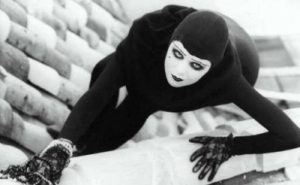 Louis Feuillade’s crime/adventure serial of 1914-15 was so extravagant in its plot and effects that it became one of the favorite films of the French surrealists.
Louis Feuillade’s crime/adventure serial of 1914-15 was so extravagant in its plot and effects that it became one of the favorite films of the French surrealists.
In the early years of the 20th century, a film genre was invented that became hugely popular: the adventure serial. Just as the publication of novels in installments had fired public interest for almost two centuries, so the serialized film story had audiences waiting in suspense for each succeeding episode. The most famous was Pathé Studio’s The Perils of Pauline. Ever in competition was France’s other big studio, Gaumont, and from that company came a series of works by its principal producer and director, Louis Feuillade, that are still considered the high point of the form.
Unlike Fantomas, his first success in the genre, Les Vampires, which screened from 1914 to 1915, was not based on previous material, but written by Feuillade himself. The story concerns a criminal gang called The Vampires, mysterious and resourceful, that terrorizes France with a succession of swindles, robberies, and murders. Aiding the often ineffectual police is Philippe Guérande, a crusading journalist, and his comic sidekick Mazamette. On the other side are a host of villains, notably a woman with an anagram for a name, Irma Vep, and a master plotter named Satanas, who includes a portable cannon in his arsenal of evil.
Shot on the back streets and alleys of Paris, the adventures have a loose, improvised feel. Characters and plot threads come and go without a great deal of logic or consistency. There are ten episodes, adding up to about seven hours. At first, it’s slow going. A lot more time is spent on mundane set-ups and establishing shots than a modern audience is used to tolerating. The straight-on camera placement, medium shots, and box-like confinement of the indoor sequences would be readily accepted by the audience of that time, but tend to be tiresome for us. Around the fourth episode, however, it seems that Feuillade and his crew started getting more into the feel of things. The plots become more and more outlandish, with missing bodies, trap doors, hypnotism, death-simulating serums, daring prison escapes, and so forth. The introduction of the Irma Vep character around this time also adds life to the proceedings. She was played by a popular Paris actress with the stage name “Musidora.”
Watching the episodes of Les Vampires back-to-back, while not the experience originally intended for audiences, habituated my mind to the form, until I was captured (or perhaps worn down) and under its spell. Eventually the film became a kind of alternate world of imagined crime, living in my head like the vision of a lost history.
Of course the stories are implausible and ridiculous, really, but Feuillade intended them to be just what they are—wild escapist entertainment, appearing not coincidentally during the first years of World War One. The fact that Feuillade made them up as they went along, with scenes being determined by factors such as the availability of an actor or a setting, gives the series a strange, darkly amusing, almost surrealistic quality.
One cannot accurately evaluate the impact of the cinema without taking melodrama into account. The most popular art form was shaped in response to mass audience taste, and Les Vampires was a fascinating milepost along the way. It’s available on DVD and in streaming format on the web.

